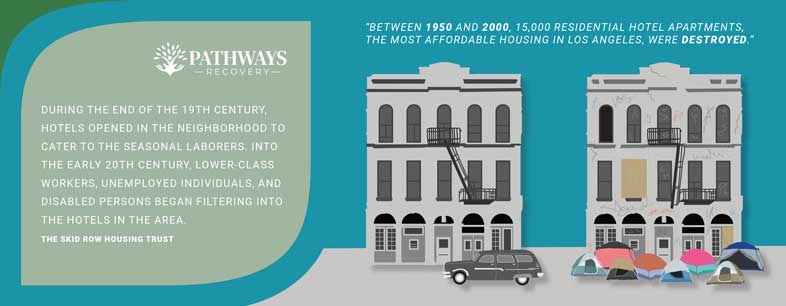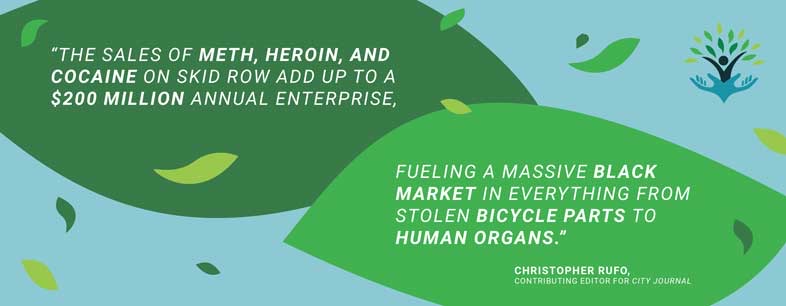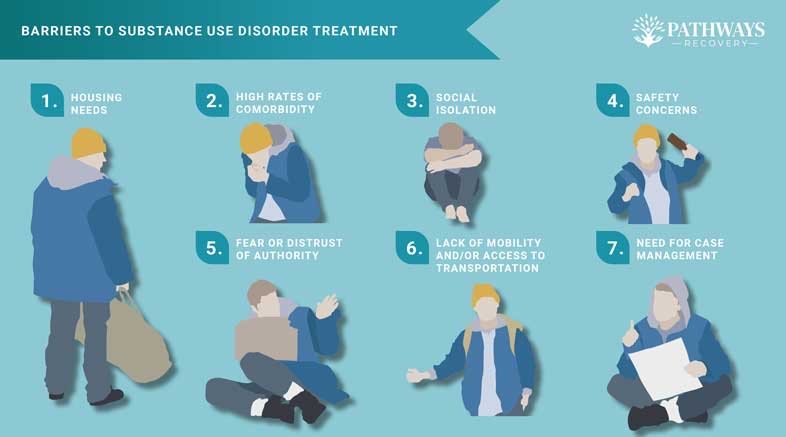California and homelessness is hardly a novel talking point. For many years, residents and politicians alike have expressed frustration with the growing homeless population and have debated back and forth about public policy that has been proposed in attempts to help the crisis.
Many areas of California have become infamous to people even outside the state. Areas like Los Angeles’ Skid Row and San Francisco’s Tenderloin are areas that are referenced as some of the worst examples of the homeless epidemic and addiction struggles. Both of these neighborhoods have become known for street drug trade, homeless populations, unsanitary living conditions, violent crime, and theft.
Within the last several years, the homelessness epidemic seems to have reached a fevered pitch of complaints, with news about tent cities, unclean streets, mental illness, and quality of life making national and local news headlines. The issues of addiction, alongside mental illness, in the homeless population remain a troubling—and sadly—highly politicized reality.
Just this past October, the San Francisco Chronicle reported that the city that is home to the famed Golden Gate Bridge is losing approximately two people each day to drug overdoses. In particular, fentanyl overdoses are spiking and causing increasing concern as the fatality numbers keep increasing.
How did things get so bad?
It might seem strange to see such a prosperous state struggle this much. After all, California has always been a state of innovation, home to Silicon Valley and numerous other business ventures. Of course, it’s home to Hollywood and Beverly Hills—the movers and shakers of the entertainment industry—not to mention the large agricultural and manufacturing scene.
California also has the highest earning economy of any state in the country, topping the charts at a whopping 14% of the U.S. GDP. According to a 2019 Markets Insider publication, if California were a country, it would have the world’s fifth largest economy, behind Germany and ahead of the United Kingdom.
Perhaps the best way to better understand these issues is to start from the beginning.
A Brief History of the Homeless Epidemic in California
Depending on whom you ask, you’ll get different answers to the question “why does California have an increasing homeless epidemic?”
However, the answer will likely be one of four things or a combination of all or some of them: housing shortages, increasing housing prices, drug addiction, and mental illness.
The answer to this question is complex and cannot necessarily be answered in a straightforward way. Asking someone this question has become increasingly political and controversial. Some groups of individuals will claim California’s homeless problem is a result of the housing crisis, but others will claim the homeless problem is a drug problem being sold as a housing crisis.
The conflict between these two sides is important to acknowledge to accurately portray the current realities of California and its legislature, but this piece does not intend to delve into the politics behind such conversations. Instead, we shall say that for certain, California does struggle with exorbitant housing prices, and it also struggles with an addiction crisis.
Since Skid Row is one of the most infamous examples, it’s worth investigating how Skid Row became what it is today.
Skid Row: Unassuming Beginnings and Infamous Legacy
Skid Row is a neighborhood in Los Angeles that’s become infamous as a center for homeless populations.
During the end of the 19th century, hotels opened in the neighborhood to cater to the seasonal laborers. Into the early 20th century, lower-class workers, unemployed individuals, and disabled persons began filtering into the hotels in the area. According to the Skid Row Housing Trust, “between 1950 and 2000, 15,000 residential hotel apartments, the most affordable housing in Los Angeles, were destroyed.”
Contributing to the demolition of buildings were the changing building codes in the 60s. Renovating buildings in order to get them up to code was an expensive task. For many building owners, demolition was a better economical option than updating the building.
Due to the demolition of a majority of that affordable housing, the gradual loss of the apartments forced many people out onto the streets and into community shelters. Large swaths of people became homeless during this time as finding lower-rent housing became increasingly difficult.
According to the BBC, beginning in 1976, “city officials established Skid Row as an unofficial “containment zone”, where homeless people, shelters, and services would be tolerated.”
In 1981, the U.S. experienced a recession and as unemployment numbers rose, the use of crack cocaine was also on the rise in major cities across the United States, including Los Angeles.
Since the 80s, government officials have argued back and forth on crackdown policies that would include enforcing anti-camping ordinances. At various times, LAPD members had proposed harsher crackdowns on homeless populations only to meet resistance from homeless advocates or local government officials who blocked proposals or refused to prosecute any arrests. The debate over the proper way forward with the homeless population continues into the modern day.
One of the most recent compromises was a 2006 compromise proposal that followed a court decision that bars the LAPD from arresting transients for sleeping on the streets or confiscating any of their possessions. These individuals were allowed to sleep on the sidewalk between the hours of 9:00 p.m. and 6:30 a.m. so long as they remained more than 10 feet away from a business or residential entrance.
More and more, Skid Row seems to have been isolated from the public. It’s become its own kind of world that has been cut off from the more glamorous surroundings of Los Angeles.
Skid Row’s 4.324 mi², Thousands of People Ripe for Substance Abuse and Addiction
Skid Row as a central hub for public and social services sees thousands of homeless individuals pass through each year. Many of these individuals experience some kind of addiction to an illicit substance or struggle with a mental illness.
Christopher Rufo, the contributing editor for City Journal, describes in his article titled “The Moral Crisis of Skid Row” his estimate that “the sales of meth, heroin, and cocaine on Skid Row add up to a $200 million annual enterprise, fueling a massive black market in everything from stolen bicycle parts to human organs.”
The interviewee in Rufo’s article, LAPD member Sergeant Pete Kouvelis, explains that Skid Row is divided into sections based on gangs. Gangs with a piece of territory in Skid Row have a vested interest in getting and keeping people hooked on substances. Street gangs here control the market for substances like meth, heroin, cigarettes, and even stolen property and prostitution.
For those looking to continue their addiction or make money off other people’s addictions, Skid Row is an ideal market. Over time, this area has become the epicenter for Los Angeles’ addiction crisis as well as becoming the poster child for California’s struggle to crack down on the drug trade and improve the homeless populations’ quality of life and opportunities.
LAPD’s attempts at disrupting the drug trade have proved to be mostly ineffective. Kouvelis is quoted as explaining that, “the population is very good at learning our tactics and then adapting their behaviors to counter our tactics.”
The drug trade and market in this area of town offers a wide variety of substances. Homeless persons on Skid Row can be addicted to an assortment of substances or a mix of drugs.
Another of Rufo’s interviewees, Mark Casanova, executive director of Homeless Healthcare Los Angeles, explains that “70 percent of [the homeless drug users on Skid Row] are crystal meth users, or a combo of crystal meth and heroin, crystal meth and cocaine. . . . The remaining percentage is probably about 25 percent heroin, and a fair number of cocaine users.”
Again, public policy is a battleground here. Rufo insightfully points out that within the last few decades, social activists for the homeless and many politicians have shifted the public policy on addiction and illicit drug use.
Where the policy used to be more punitive, focusing more on prohibition and incarceration, now the philosophy has changed to the focus of “harm reduction.” This approach views widespread drug use as something that is an expected and normal occurrence and instead of focusing on the punitive aspects, attempts to reduce rates of infection and complications for users.
The priority is on ensuring users are as safe as possible while using, thus accepting the initial behavior of illicit substance use as a given.
Homeless Populations’ Access to Treatment and Addiction Rehab Centers in Sacramento, California
The Sacramento Public Health Department estimated that somewhere between 10,000 and 11,000 Sacramento residents would experience homelessness in 2019. The department reached out to a group of individuals who identified as homeless in one particular count.
According to a published slideshow report of some recent findings and future plans titled Alcohol and Drug Services For Persons Experiencing Homelessness, of the 5,570 individuals that made up this particular homeless population, nine percent of individuals reported that drug and alcohol use prevented them from holding down a job or stable housing. This group consisted of 52% men and 48% women.
Additionally, in more general terms, the department claims some 60% of respondents said that they use alcohol or non-medical drugs. However, only 15% of those respondents indicated that they believed alcohol or drug use impacted their ability to hold a job or secure stable housing.
These numbers may seem high or low, depending on the perspective and background of an individual looking at this data. However, one thing is clear: substance use disorders do affect people in the homeless populations in Sacramento and across California. The impact of a substance use disorder, even in the life of one person, can evolve into a path that leads to negative mental and physical consequences.
Outside of politics, it seems reasonable to presume that nobody wishes to see a person’s life negatively affected in any way. Some proportion within the homeless populations clearly has some degree of struggle with substance use and addiction and reports an impact of that use on their professional career and ability to have a stable home.
Of course, nobody wishes to see a person’s life made more difficult by substance use disorders. This is why examining and reducing barriers to treatment is important if any progress and positive change is to be made in the quality of life of California’s homeless population.
Barriers to Substance Use Disorder Treatment in California
The Sacramento Public Health Department has identified several barriers to accessing addiction treatment in the homeless community. The presentation lists the following as probable reasons:
- Housing needs
- High rates of comorbidity
- comorbidity (n): simultaneously present medical conditions in an individual
- Social isolation
- Safety concerns
- Fear or distrust of authority
- Lack of mobility and/or access to transportation
- Need for case management
The department also touches on the issues of stigma that surround addiction and addiction treatment. Although substance use disorders might be coated in a negative connotation by society, ignoring the reality of these struggles and the people who struggle daily with this, it hardly improves the situation or health of any person struggling with addiction.
The Sacramento Public Health Department cites the Surgeon General’s Report on Alcohol, Drugs, and Health, explaining that while 1 in 7 people in the United States are expected to develop a substance use disorder, only 1 in 10 people receive treatment.
Looking Forward: Healing and Addiction Treatment in California
It would be unrealistic to expect California’s complex issues surrounding homelessness, housing, addiction, and mental health to be resolved in any short period of time.
Instead of looking towards timelines, Pathways Recovery chooses to look towards making meaningful connections with individuals and improving the life of one individual at a time. Pathways believes in combating the stigma that surrounds addiction treatment. Instead, the treatment center sees the potential of improvement in physical and mental health through exercise and nutrition, as well as building up mental and emotional strength.
Holistic, individualized addiction treatment is a way forward that offers a new, better chance at life for those who have suffered from the impacts of addiction.
For those looking for a quality, individualized addiction treatment program for men just outside of Sacramento, visit Pathway Recovery’s website or call 916-735-8377 to get in contact with a qualified counselor.







